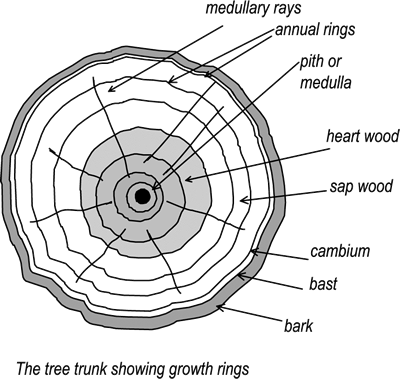 When looking at a cross section of a log, the central wood portion is usually considerably darker than the part adjacent to the bark. The light coloured wood is called sapwood, and the remainder is the heartwood.
When looking at a cross section of a log, the central wood portion is usually considerably darker than the part adjacent to the bark. The light coloured wood is called sapwood, and the remainder is the heartwood.
As described in Production of wood in a tree sapwood is composed of new cells that form vertical conduits for water and nutrients from the roots to the leaves. (In hardwoods they form the conduits by creating vessels with cells as a pipe wall, and in softwoods, the cells are the conduits themselves.) The walls of the hollow cells are still growing inwards, and are laden with starches for their own growth.
 Heartwood appears to form the main structural support for trees and it is generally thought that the inclusion of extractives are the main reason why the natural durability of heartwood is enhanced. The amount of sapwood present in a trunk is species dependent, varying from a narrow band of 10 mm for some hardwoods to a large proportion of the cross-section for some softwoods. There are numerous theories as to why sapwood is converted into heartwood, but it seems that as the tree gets larger and matures, parts of the cross-section conducting sap and storing food reserves become redundant.
Heartwood appears to form the main structural support for trees and it is generally thought that the inclusion of extractives are the main reason why the natural durability of heartwood is enhanced. The amount of sapwood present in a trunk is species dependent, varying from a narrow band of 10 mm for some hardwoods to a large proportion of the cross-section for some softwoods. There are numerous theories as to why sapwood is converted into heartwood, but it seems that as the tree gets larger and matures, parts of the cross-section conducting sap and storing food reserves become redundant.
The redundant sapwood is converted into heartwood that is physiologically inert, and a balance is reached whereby the starches previously stored in these sapwood cells are released to promote the production of more wood. Heartwood therefore has a much lower starch content, and the hollow cells are filled with extractives that are sometimes toxic to fungi and insects giving it much higher durability than sapwood.
Sapwood is much less durable than heartwood and often has marginally lower structural properties. The high starch content in sapwood makes it very attractive to fungi (rot-producing organisms) and insects. Some insects such as lyctus generally lay their eggs in the hollow cells. In heartwood where the cells are already full of extractives, the eggs cannot be laid and the woodconsuming larvae cannot be produced. Most heartwood is, therefore, not susceptible to lyctus attack.

